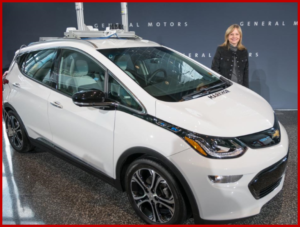Two autonomous driving cars traveled ~300 miles before arriving in Traverse City for the CAR Conference as part of an demonstration by Continental and Magna International. The demonstration started in southeast Michigan to the Center for Automotive Research’s annual Management Briefing Seminars.
The automated driving vehicles – a Cadillac CTS and a Chrysler 300 – crossed into Windsor, Ontario before going north to Sarnia, Ontario and returning into Michigan. The first cross-border demonstration of its kind – much more than a hands free publicity stunt – allowed the Michigan Department of Transportation (MDOT) and the Ontario Ministry of Transportation (MTO) to test autonomous driving technology in a variety of settings.
“The MDOT team is happy to support the auto industry and job providers as they keep Michigan in its historical position as the world’s leader in mobility,” said Kirk T. Steudle, Director, MDOT. “Today’s cross-border demonstration of an automated vehicle represents unprecedented collaboration between two nations and private industry.”
“With operations in both Ontario and Michigan, Magna can clearly see the benefits of cross-border collaboration as we have on this project,” said Tom Toma, Global Product Manager, Magna Electronics.
Through Continental’s Cruising Chauffeur function, the vehicles can take over driving tasks on various roadways in accordance with traffic regulations. Once Cruising Chauffeur is activated, data analyzed in a central control unit called Assisted & Automated Driving Control Unit is used to generate a 360-degree model of the vehicle’s surroundings. In combination with a high-resolution map, the system it’s claimed recognizes all moving and static objects, as well as the layout of the roadway ahead.
The drive demonstrates how the vehicles’ multiple camera, radar and LIDAR sensors will interact while being driven underwater through the concrete Detroit-Windsor Tunnel and across the steel Blue Water Bridge. Continental’s worldwide development of automated driving includes six key elements: sensor technology, cluster connectivity, human-machine dialog, system architecture, reliability and the acceptance of automated driving.
To mark the event as the latest example of partnerships in the Great Lakes region, MDOT and OMT signed a memorandum of understanding at the drive’s completion to promote growth of connected and autonomous technology testing and deployment.
“Ontario is proud to be part of North America’s first national, cross border test drive in our Automated Vehicle Pilot Program,” said Steven Del Duca, Minister of Transportation, Ontario. “Today’s test drive is a great example of the continued collaboration and innovation between Ontario and Michigan. This new memorandum of understanding and our recent commitment of $80 million for an Autonomous Vehicle Innovation Network signify the importance of a strong, cohesive partnership and continued investment in the development of AV/CV technologies and the mobility sector.”
This is the second such agreement between Michigan and Ontario, with this most recent partnership aimed at exploring rules and regulations, as well as data collection and sharing.
Both Michigan and Ontario have taken steps to ensure the region remains competitive as the automotive landscape evolves. In 2016, Gov. Rick Snyder signed a package of bills enabling automated vehicles to operate on roads across the state. That same year, Ontario became the first province to set a regulatory framework to permit testing of automated vehicles, making it the only province to have an automated vehicle pilot program in Canada.
Ontario and Michigan’s long-standing history of collaboration in not only driving innovation within the auto industry, but connecting businesses across the border and advancing both countries’ knowledge-based economies. These moves will help ensure that the Great Lakes Automotive cluster emerge as the epicenter of automotive innovation.
The following agencies assisted with the coordination of crossing the international borders: Canadian Customs and Border Protection, U.S. Customs and Border Protection, Detroit Windsor Tunnel, MDOT Blue Water Bridge, Canada Border Services Agency and Federal Bridge Corporation.


